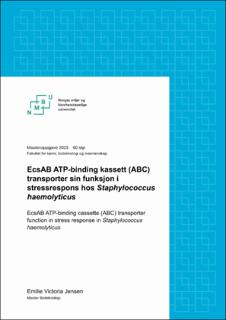| dc.contributor.advisor | Dzung Bao Diep | |
| dc.contributor.advisor | Thomas Førland Oftedal | |
| dc.contributor.advisor | Ingrun Alseth | |
| dc.contributor.advisor | Morten Kjos | |
| dc.contributor.author | Jensen, Emilie Victoria | |
| dc.date.accessioned | 2023-07-06T16:27:16Z | |
| dc.date.available | 2023-07-06T16:27:16Z | |
| dc.date.issued | 2023 | |
| dc.identifier | no.nmbu:wiseflow:6839614:54592649 | |
| dc.identifier.uri | https://hdl.handle.net/11250/3076736 | |
| dc.description.abstract | Staphylococcus haemolyticus er et økende problem innen humanmedisin hvor den ofte forårsaker hudinfeksjoner i mennesker med svekket immunforsvar. Samtidig gjør dens virulensegenskaper, som biofilmdannelse og antibiotikaresistens, behandling utfordrende. Derfor har alternative behandlingsmetoder som bakteriociner, små antimikrobielle peptider, blitt undersøkt om de kan bidra i å behandle infeksjoner av S. haemolyticus. Et nytt konstruert bakteriocin hybrid 1 (H1), er vist å være aktiv mot denne arten. Likevel har det blitt sett at resistente celler er utbredt når bakteriocinet testes in vitro, på grunn av celler med spontane mutasjoner i regulator av sigma-E protease (rseP) genet og/eller et gen kodende for en ABC-transporter kalt effekt på eksoproteiner, defekt i kompetanse og sporulering AB (ecsAB). Bakteriocinet H1 er vist å drepe målceller via en interaksjon med RseP, og EcsAB har en viktig men ukjent kobling til RseP. Genene for disse er vist å være viktige for stressrespons, virulens og biofilmdannelse i flere andre arter, men funksjonen i S. haemolyticus er ukjent.
I denne oppgaven var målet å få en økt forståelse for hvilken rolle EcsAB har i biofilmdannelse og stressrespons til S. haemolyticus, og som følge undersøke om H1- resistente mutanter har svekket levedyktighet. Dette ble gjort ved å undersøke og sammenligne fenotypiske forskjeller mellom villtype og mutanter med ikke funksjonelt EcsB. Virulensegenskaper, slik som motstandsevne mot ulike antimikrobielle midler og evne til å danne biofilm ble undersøkt. For å få en dypere innsikt i genregulering ble forskjeller i mRNA nivåer av ulike gener hos mutant og villtype undersøkt med og uten stress. Dette ble undersøkt ved å utsette cellene for bakteriocinet garvicin KS (GarKS) og undersøke genuttrykk av et utvalg sentrale gener med revers transkriptase-kvantitativ polymerasekjedereaksjon (RT-qPCR).
Resultatene viste at mutanter av S. haemolyticus med ikke fungerende EcsAB hadde en svekket evne til å danne biofilm sammenlignet med villtype og svakere motstandsevne mot GarKS. I tillegg viste RT-qPCR analysen signifikante forskjeller i uttrykk av DUF418 (protein med ukjent funksjon) og stafylokokk respiratorisk respons A (srrA), der villtype hadde en høyere oppregulering av disse genene under stress enn det sett for ecsB-mutanten. Dette kan tyde på at reguleringen av disse genene er sterkt knyttet til EcsB og at disse genene er viktig for normal stressregulering hos S. haemolyticus. | |
| dc.description.abstract | Staphylococcus haemolyticus is an increasing problem in human medicine where it often causes skin infections in people with weakened immune systems. At the same time, its virulence factors such as biofilm formation and antibiotic resistance make treatment challenging. Therefore, alternative treatment options such as bacteriocins, small antimicrobial peptides, have been investigated to see if they can treat S. haemolyticus infections. A newly engineered bacteriocin hybrid 1 (H1) has been shown to be active against this species. Nevertheless, it has been observed that resistant cells are prevalent when the bacteriocin is tested in vitro due to cells with spontaneous mutations in the regulator of sigma-E protease (rseP) and/or an ABC-transporter named effect on exoproteins, defect in competence and sporulation AB (ecsAB). These genes have been shown to be important for stress response, virulence, and biofilm formation in several other species, but the functions in S. haemolyticus are still unknown.
In this thesis, the aim was to gain an increased understanding of the role EcsAB has in biofilm formation and stress response in S. haemolyticus, and as a result investigate whether H1- resistant mutants have impaired fitness. This was done by examining and comparing phenotypic differences between wild type and mutants with non-functional EcsB. Virulence properties, such as resistance to various antimicrobial agents and ability to form biofilm were investigated. To gain a deeper insight into gene regulation, differences in the mRNA level of various genes in mutant and wild type strains were investigated with and without stress. This was investigated by exposing the cells to the bacteriocin garvicin KS (GarKS) and examining gene expression levels of a selection of genes by reverse transcription-quantitative polymerase chain reaction (RT-qPCR).
The results showed that mutants of S. haemolyticus with non-functioning EcsAB had a weakened ability to form biofilm compared to wild type and weaker resistance to GarKS. In addition, RT-qPCR analysis showed significant differences in the expression of DUF418 and srrA, where wild type had a higher up-regulation of these genes under stressful conditions than seen for the ecsB mutant. This may indicate that the regulation of these genes is strongly linked to EcsB and that these genes are important for normal stress regulation in S. haemolyticus. | |
| dc.language | nob | |
| dc.publisher | Norwegian University of Life Sciences | |
| dc.title | EcsAB ATP-binding kassett (ABC) transporter sin funksjon i stressrespons hos Staphylococcus haemolyticus | |
| dc.type | Master thesis | |
